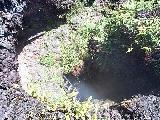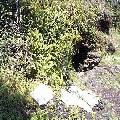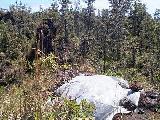
As you head on down to south Puna from north Puna you first have to cross the great divide or rift zone where the evidence of the island being torn in two is visible. The rift zone has generally been pushed higher into a mini mountain range if you will.
At this line of demarcation at the very crest of the ridge along the highway from Pahoa to Kalapana are the steam vents. This particular one is further back and doesn't seem to get as much traffic. As you see you descend into the bowels of the earth via a conveniently provided ladder.


